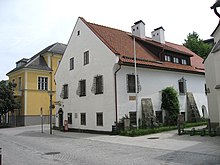Heimathaus Vöcklabruck
The Heimathaus Vöcklabruck is a museum in Vöcklabruck . This is housed in the former benefit house and is a listed building . The museum was opened in 1937 on the initiative of District Captain Prince Alfred zur Lippe-Weißenfeld.
building
The building was first mentioned in a document in 1508. It fell victim to a major fire in 1542, although the core of the building is likely to be from the 12th to 13th centuries. contain. On the outer walls, two 60 cm wide remains of the wall, which come from the original city wall, catch the eye. In the garden is one of three preserved Roman milestones. However, this is in poor condition because it was processed in a paper mill.
Ground floor
On the ground floor there are primarily items of rural life. In addition to the hallway and a hall room, it is divided into a farmhouse parlor, a smoking kitchen, a bedroom and an equipment room. The exhibits include ornamental and jewelry items such as gold bonnets, skulls, ceramics, various items of clothing and jewelry. The farmhouse parlor is dominated by a wooden ceiling, a tiled stove made of Gmundner ceramics and the opposite table with a Herrgottswinkel. In the bedroom there is mainly farm furniture, such as a four-poster bed, a farmhouse chest, a showcase, a cradle and a farmhouse chest. There are icons and crucifixes on the walls, as well as an embroidery pattern. Tools were collected in the equipment room adjacent. In addition to pitchforks and flails, a loom and a spinning wheel can be viewed. In addition, on the ground floor there are three watercolors by Ernst August von Mandelsloh and a pipe by Franz Stelzhamer , who is said to have written his poem A Funny Eicht in Vöcklabruck .
First floor
The first floor is dedicated to middle class life. In addition to the central hall, it is divided into a Renaissance, a Baroque and a Biedermeier room, as well as a guild room, a small chamber on the town's history, and a room for Anton Bruckner and his biographer Max Auer . In the hall there are various wooden figures, a guild flag, a baroque cupboard, a table and another peasant chest with some figures of the Madonna. The city history room contains various documents, coats of arms and pictures. In addition to the wooden ceiling from 1639 from a house in Kremsmünster, the Renaissance room contains a table from 1630, associated chairs and an extensively renovated crucifix from around 1500, as well as a picture of the Frankenburg dice game . A crucifix by Meinrad Guggenbichler hangs next to various paintings in the Renaissance room . One of the most impressive rooms is the guild room with a large number of guild signs and smaller items. In addition to some furniture, the Biedermeier room contains a showcase with glasses from the Freudenthal glassworks .
Second floor
On the second floor there is initially a room with various militaria from the morning star to swords and various rifles and a soldier . In the other accessible room there are older finds from the pile-dwelling and Bronze Age, as well as a mosaic of a Roman villa in Weyregg.
basement, cellar
A nativity scene with around 300 figures was set up in the basement.
literature
- Museum guide through the Vöcklabrucker Heimathaus / City Museum by DDr. Franz Satzinger, Kilian Verlag Vöcklabruck
Web links
Coordinates: 48 ° 0 ′ 26.6 ″ N , 13 ° 39 ′ 18.1 ″ E







